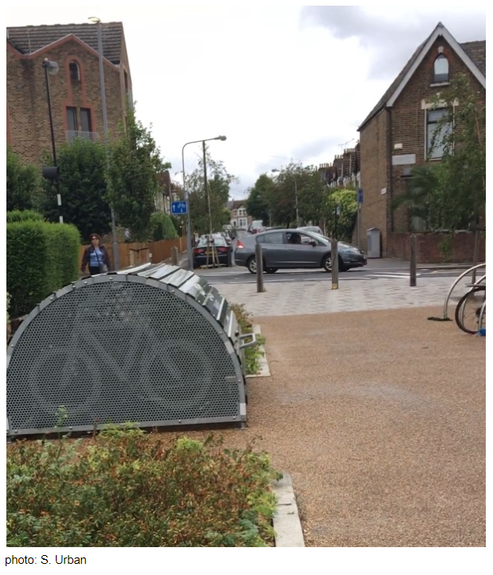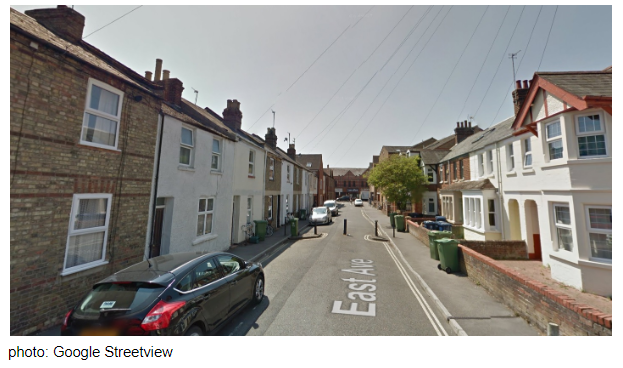|
Pictured below is a 'traffic filter'. It's a place where cycles, buggies, wheelchairs, scooters and people on foot flow through freely and comfortably -- albeit at the cost of cars doing so. That's why it's called a filter. This one's got a lot of charm. But a few bollards will do. In Oxford you can see them on East Avenue, Clive Road, Meadow Lane and elsewhere. It was at this particular filter that I met Fran (not her real name). I was asking passers-by what they thought of the filter and the overall changes to the neighbourhood. "Me?" asked Fran.. "I love it. I supported it from the start. But my husband didn't. It meant he had to drive 500 metres out of his way to get to work. And the through-streets were more clogged. But then he decided it made more sense to walk to work. And he did, and he's lost weight -- and I fancy him more!" That is traffic filtering. For driving, an added inconvenience. For health and social well-being, a major boost. It's a carrot and a stick. Fran's husband is getting a stick from the added nuisance of having to drive further to get out of his neighbourhood. But he has a carrot too. So what's the big deal if we already have these in Oxford (like this one on East Avenue, pictured below)? The big deal is that where I interrogated the passersby -- in the Blackhorse Village neighbourhood of the borough of Waltham Forest -- filters have been used to keep through-traffic out of neighbourhoods. These neighbourhoods range from ½ to one square kilometre. These are 'low traffic neighbourhoods' or LTNs (also known as 'liveable neighbourhoods'). The other characteristic of LTNs is that the whole area is taken into consideration. If, by closing one rat-run you would inevitably create another, you close that one too. The whole LTN is non-rat-runnable. To be clear: these are not street closures. All homes and addresses in an LTN are accessible by car. But it is no longer possible to drive through the LTN, from one side to the other -- as you can currently do on Littlehay/Cornwallis in Florence Park, for example. There is also no pedestrianisation necessary in an LTN. Waltham Forest did two high-street pedestrianisations as part of its overall programme, and those seem to have been the most controversial elements. The process of getting these LTNs implemented in Waltham Forest has been challenging. Such a major change to accustomed practice is understandably upsetting for many. In Walthamstow, there seems to be a kind of received wisdom about them. It goes like this: "Well, I like x, y, z aspect of [LTN], but... "if you lived on a perimeter road you'd hate them" or "if you were a trades person you'd hate them" or "they make me feel less safe". I asked Fran if the traffic behind us -- in the picture above -- was so bad. It seemed incredibly quiet. "That's the thing!" she said. "Everybody bangs on about the added traffic but actually some people must have changed their habits [like her husband!] because it's not that bad anymore." She's describing a phenomenon known as 'traffic evaporation'. Traffic is not a liquid that needs to go somewhere -- squeeze it out of one place, and it appears somewhere else. A portion of it just goes away as some people substitute into other modes. And indeed, at least at that point in time -- bang-on midday on a Thursday -- the roads flowed fine. Florence Park So why Florence Park? On 2 April, 2019, a local resident posted the following message on a neighbourhood-oriented discussion platform: 'Hi neighbors, a car almost hit me and my girls this week at the junction between Rymers, Littlehay and Cornwallis, and I was inspired to write to our County Councillor to ask him to make Flo Park safer for its pedestrians, cyclists and car drivers. Below is my letter - feel free to copy and then obviously change it to make it true to your own experiences..' The very next day, a local resident was knocked off her bike amidst a car collision in that very junction. She was hospitalised with multiple fractures to her pelvis. That's when the Florence Park Traffic Group formed, to hold a meeting in the community centre and discuss solutions. I've summarised that meeting here. The fundamental question is whether rat-running traffic has any business avoiding the main roads intended to be used for through-traffic. The view of Waltham Forest borough council was 'no' and, fortunately for them, they had a £29 million grant from Transport for London to start making changes. That figure is sometimes cited as a reason why LTNs cannot be done elsewhere. But it's not quite so. The £29 million funded a variety of improvements, of which the creation of LTNs via traffic filters was a small part. The figure for an area the size of Florence Park is likely to be between £50k-100k depending upon the types of filters used, approach to the Number 16 bus route, and other details. Cars or kids So it comes down to free-flowing cars or kids -- you can't have a neighbourhood with both. I've written about Britain's growth in car usage, and the trouble that's causing us as a society -- even if all the cars become electric. But we know for certain that any proposal to create an LTN will be upsetting. And many people will get organised. And they'll get the attention of councils. And that's why this has happened exactly nowhere apart from Waltham Forest. Twenty-one London boroughs bid for the £29 million grants. Only three of these were ambitious enough to be accepted. Of those, only one borough has gone through with it. But that's the thing -- the majority who appreciate these changes are pretty quiet about it, while the minority who loathe them are noisier. Why do I say the majority? Because when the Waltham Forest borough council went up for re-election in 2018, there was a real fear that voters would abandon the councillors who supported the scheme. Deputy leader Clyde Loakes as portfolio holder for environment was the most highly exposed to the protests, being the borough councillor most identified with the programme of liveability improvements. He penned his resignation letter before the elections. In the event, he was returned to office with the biggest majority in his 20-year career. Every single councillor who supported the changes was voted back in. What we hear about Waltham Forest, from the outside, is that the changes have been controversial. That's an understatement. But do the criticisms hold up? It might just be the case that there's a conventional wisdom about the changes, along the lines that despite the many benefits they've brought, they've created problems x, y and z. I will blog about those more specifically next time. But it reminds me of something Jacques Wallage (you can find him in this article) told an audience in Oxford about the liveability changes in Groningen, Netherlands forty years ago. "The only public voices we heard were against us. The police were against us. We would never have done it except that we knew it was the right thing to do." Many political groups have assumed control of the city's administration since then. Not a single one has dared undo those liveability improvements, nor would they have any reason to. The liveability of Dutch towns and cities is the envy of the world. Glossary
This blog contains the opinions of the author and does not necessarily reflect the opinions of any of the Co-CAFE team or Oxford Brookes University.
2 Comments
|
AuthorsCo-CAFE is led by Tim Jones (Reader in Urban Mobility) with Ben Spencer (Research Fellow) and Tom Shopland (Co-CAFE project administrator) based in the School of the Built Environment at Oxford Brookes University. Archives
February 2020
Categories |
|
Oxford Brookes University
School of the Built Environment +44 1865 48 4061 |
|
Funded by the Lifelong Health and Wellbeing cross-Council programme. Grant No. EP/KO37242/1
|



 RSS Feed
RSS Feed


